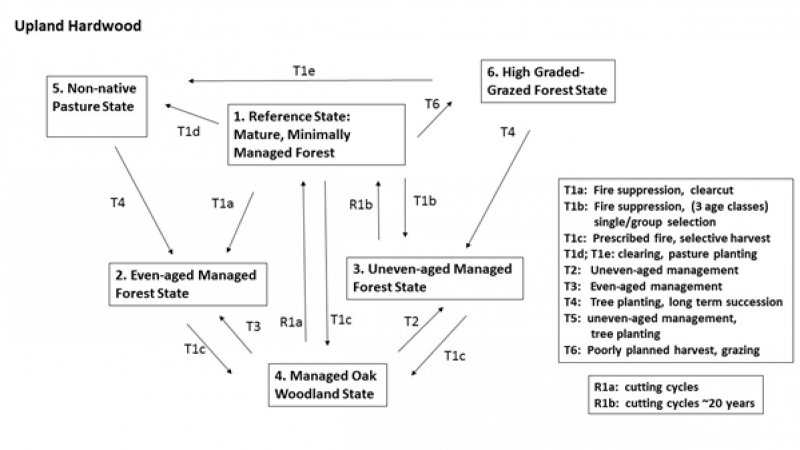
Natural Resources
Conservation Service
Ecological site PX136X00X820
Acidic Upland Forest, Moist
Accessed: 12/24/2024
General information
Provisional. A provisional ecological site description has undergone quality control and quality assurance review. It contains a working state and transition model and enough information to identify the ecological site.
MLRA notes
Major Land Resource Area (MLRA): 136X–Southern Piedmont
This area is in North Carolina (29 percent), Georgia (27 percent), Virginia (21 percent), South Carolina (16 percent), and Alabama (7 percent). It makes up about 64,395 square miles (166,865 square kilometers). (Ag Bulletin 296)
The northeast-southwest trending Piedmont ecoregion comprises a transitional area between the mostly mountainous ecoregions of the Appalachians to the northwest and the relatively flat coastal plain to the southeast. It is a complex mosaic of Precambrian and Paleozoic metamorphic and igneous rocks with moderately dissected irregular plains and some hills. (EPA Ecoregions descriptions)
ADD APPROPRIATE ECOREGION DESCRIPTION(S)
Classification relationships
A PROVISIONAL ECOLOGICAL SITE is a conceptual grouping of soil map unit components within a Major Land Resource Area (MLRA) based on the similarities in response to management. Although there may be wide variability in the productivity of the soils grouped into a Provisional Site, the soil vegetation interactions as expressed in the State and Transition Model are similar and the management actions required to achieve objectives, whether maintaining the existing ecological state or managing for an alternative state, are similar. Provisional Sites are likely to be refined into more precise group during the process of meeting the APPROVED ECOLOGICAL SITE DESCRIPTION criteria.
This PROVISIONAL ECOLOGICAL SITE has been developed to meet the standards established in the National Ecological Site Handbook. The information associated with this ecological site does not meet the Approved Ecological Site Description Standard, but it has been through a Quality Control and Quality Assurance processes to assure consistency and completeness. Further investigations, reviews and correlations are necessary before it becomes an Approved Ecological Site Description.
Ecological site concept
This forest is found on dry to intermediate moisture uplands throughout the thermic soil temperature regime of the Southern Piedmont. It favors mid- to upper-slope positions with northerly or easterly aspects, or mid- to lower slopes with more southerly aspects. In drier landscapes, this type occupies habitats considered relatively mesic (e.g., concave slopes, lower slopes, shallow ravines). Forest stands are closed to somewhat open and are dominated by mixtures of oaks and hickories. Hickory species are more common in the understory. In forests with a history of disturbance, such as selective logging or windstorms, early-successional species such as Liriodendron tulipifera or Pinus sp. may codominate. In Virginia examples, Quercus prinus is inconstant but sometimes important. In addition, Pinus spp., Liriodendron tulipifera, Liquidambar styraciflua, and Acer rubrum may be common. Understory species include Acer rubrum, Cornus florida, Oxydendrum arboreum, Ilex opaca, and Nyssa sylvatica. Shrubs include Vaccinium stamineum, Vaccinium pallidum, Viburnum acerifolium, Viburnum rafinesquianum, and Euonymus americanus. The woody vines Vitis rotundifolia and Toxicodendron radicans often are present. Herbs vary from sparse to moderately dense, with dry-mesophytic, acid-tolerant species such as Hexastylis spp., Goodyera pubescens, Chimaphila maculata, Desmodium nudiflorum, Maianthemum racemosum, Polygonatum biflorum, Viola hastata, Tipularia discolor, and Hieracium venosum prevalent.
Table 1. Dominant plant species
| Tree |
(1) Quercus alba |
|---|---|
| Shrub |
(1) Vaccinium stamineum |
| Herbaceous |
(1) Desmodium nudiflorum |
Legacy ID
F136XY820GA
Click on box and path labels to scroll to the respective text.

